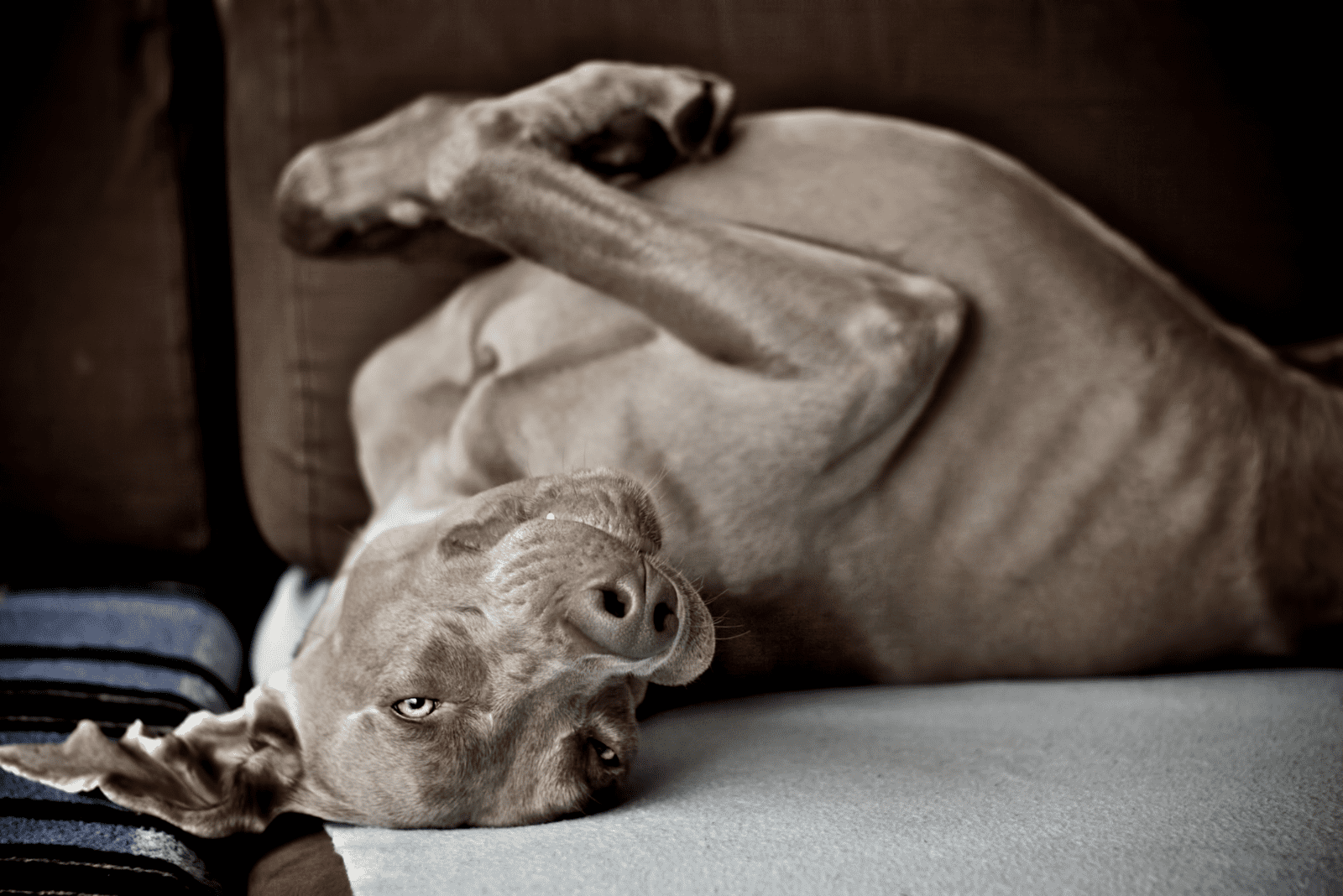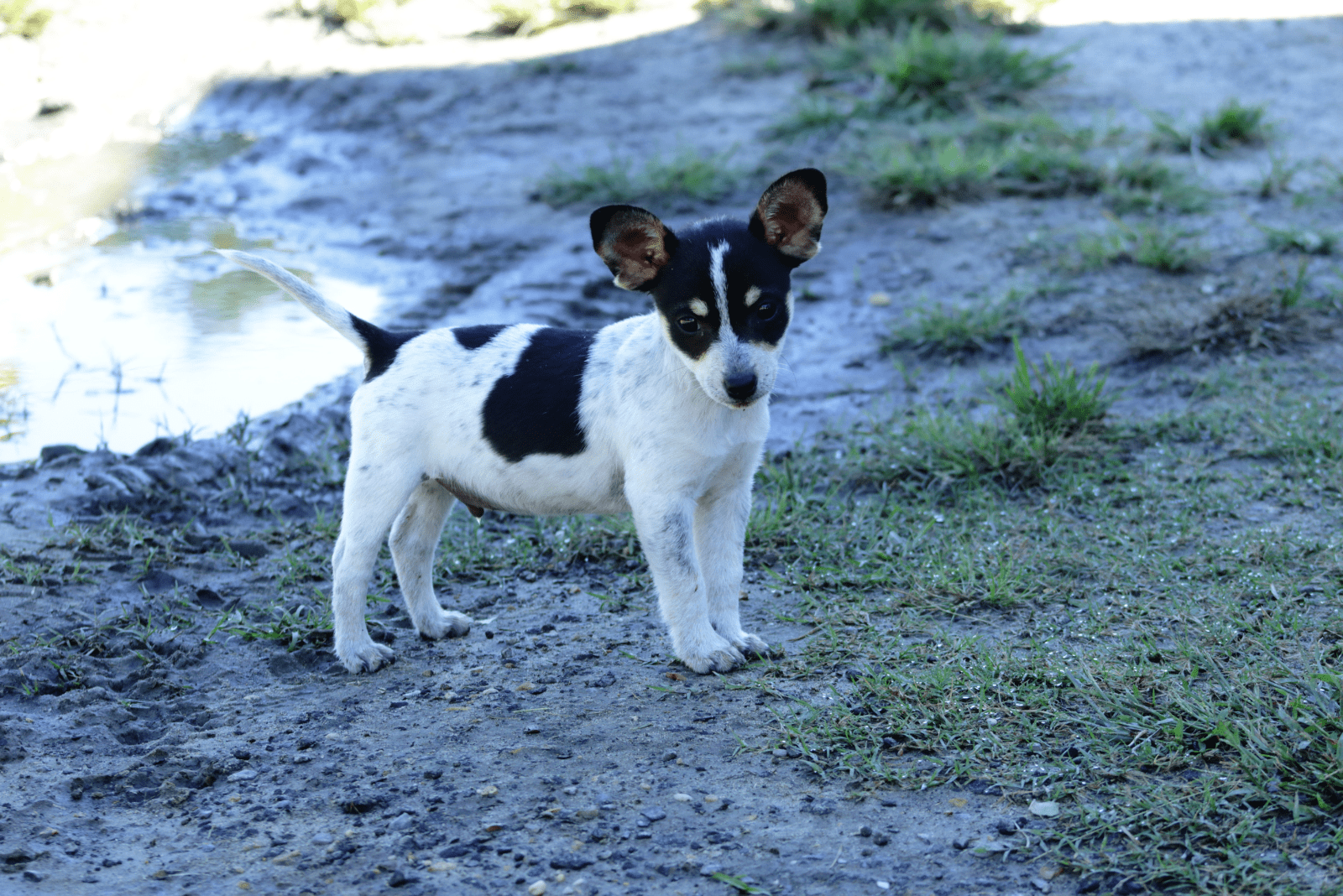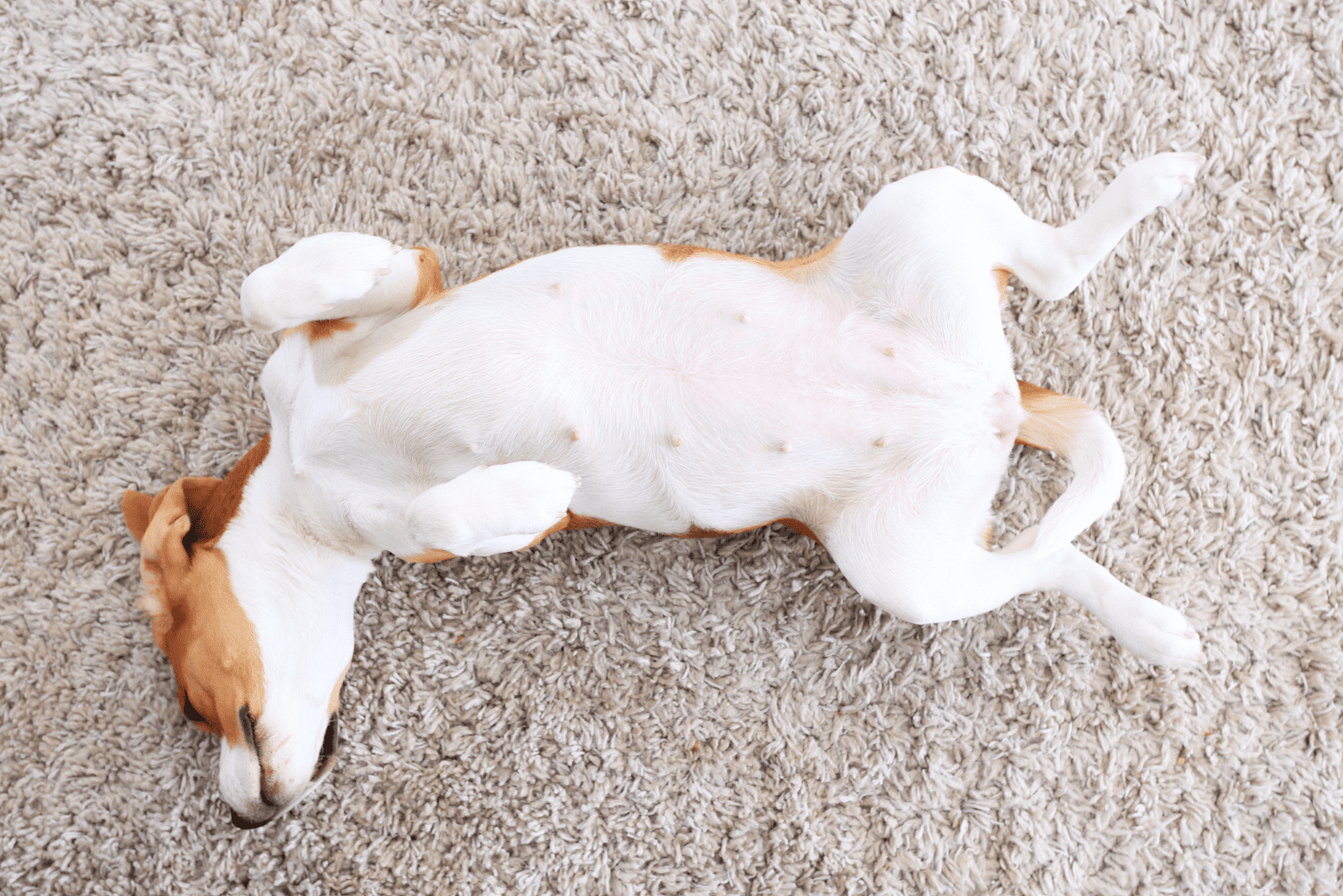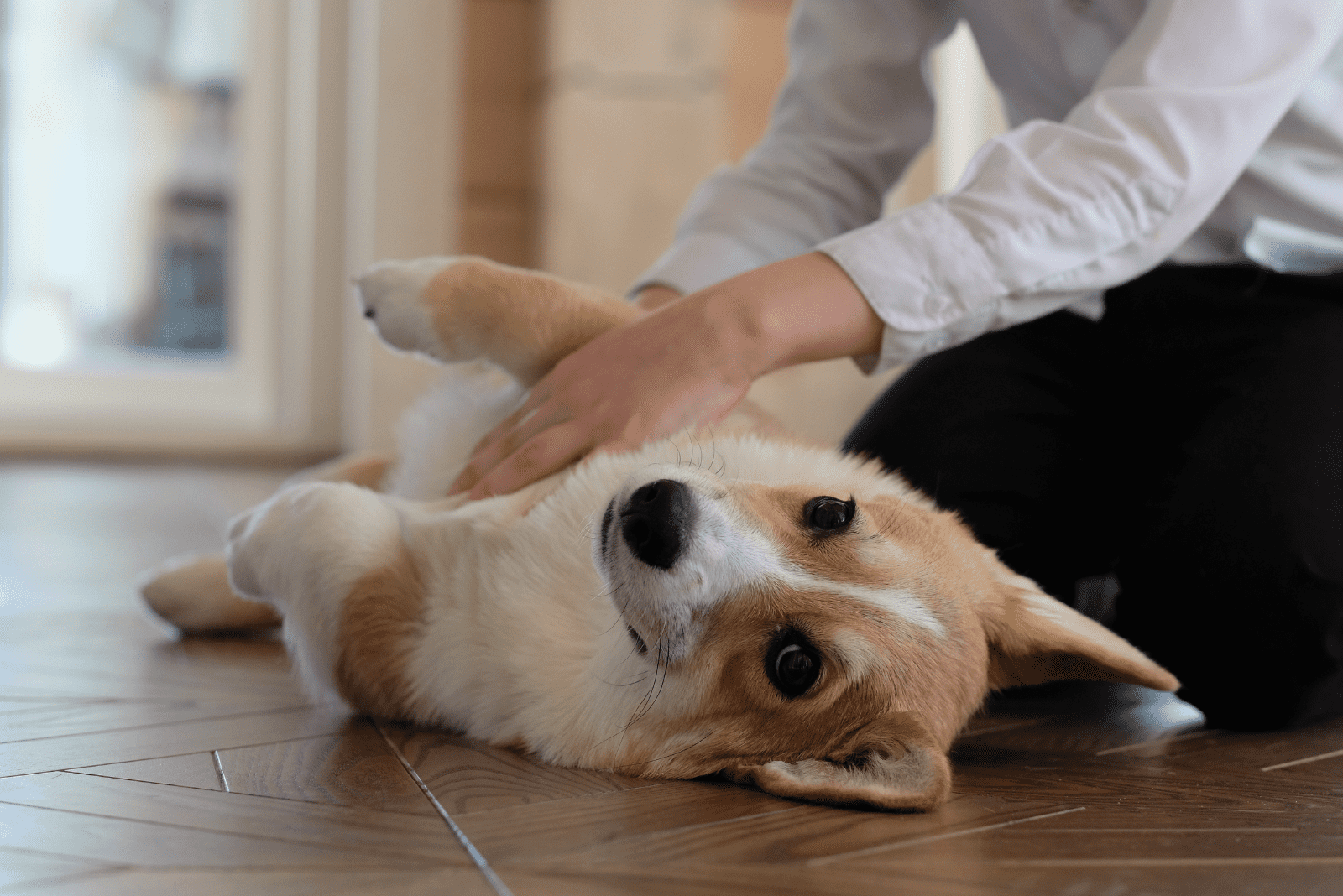Stomach problems in dogs are mostly because they ate something they should not have or decided to just swallow their food without chewing. Occasionally, you will see them sitting with their “beer belly” and looking at you with the expectation you will know what is going on.
A noticeably bigger than normal stomach probably sent you rushing to the computer searching “dog swollen stomach no pain” on Google. Welcome to the place that provides answers to all your questions. We are like a dog magic eight ball. Shake the site and stuff will be revealed to you.
As you are probably in a rush to find out what is bothering your dog’s stomach, let me begin by introducing the mighty dog’s digestive system and a list of conditions known to cause tummy swelling.
What Are The Causes Of A Dog’s Swollen Stomach No Pain?

The most important thing to assess is the pace of the symptom. A swollen stomach is always a symptom of something going in the wrong direction inside the dog’s body. Many times, owners get caught by surprise by how quickly the stomach becomes enlarged.
Most commonly, a swollen stomach is caused by the food or water that your dog ingested. In many aspects of life, the most straightforward explanation is the right one. Sometimes, dogs can be clumsy or simply careless and injure their stomach without showing pain.
There are conditions that cause a swollen stomach without the dog showing pain, but in some cases, the dog will feel pain without being vocal about it. They are genuinely considerate beings.
Bloat In Dogs Is A Compliment To The Food Or…
We all know what food means to most dogs. Even though they are not starving, they will chomp it down like they have never eaten before. Every new day is an opportunity to break the feeding time record.
If you feed your dog cooked homemade meals, this can be a testament to your culinary prowess. We know that digestion starts in the mouth and that salivation helps food go down easier which why dogs drool (so do we) at the thought of food.
However, your dog’s appetite might disagree, and it will skip the chewing part to simply gulp the food. Bloat is much more common in dogs that eat solid foods that are not cut into smaller pieces. With every big chunk, the dog will take a certain amount of air with the food.
This can create pockets of empty space (not really empty, they are filled with air) that can trap gastric gases and, in turn, cause a bloated stomach. This condition is called gastric dilatation or gastric distention and can last for a few hours or even days.
Not controlling how much your dog eats or allowing it free access to food can make overeating a real problem. It will increase the chance of distended stomach and many other intestinal problems.
See Also: Will A Dog With Bloat Drink Water? Useful Tips
Symptoms Of Bloat
The onset of stomach enlargement due to gastric distention is pretty fast, and you will most likely notice it soon after your dog finished its meal. Your dog will often show no signs of distress because it is kind of a natural process. It happens in the wild too, and can resolve on its own.
However, if the stomach keeps expanding or it happens regularly after meals, you should immediately call your veterinarian. Waiting for it to resolve can be fatal for your canine.
Something animals in general do to try and dislodge the food to release the trapped pockets of air is pacing. Your dog might appear nervous or restless. That can be accompanied by retching and drooling.
Bloat can be fatal for dogs if it does not resolve on its own or is left untreated. In those cases, it will progress into Gastric dilatation and Volvulus, both of which require a prompt reaction.
Gastric Dilatation-Volvulus
These two condition are not one and the same process. Gastric dilatation is the enlargement of the stomach and we just talked about it in the previous section. The two do go hand in hand though as volvulus follows in serious cases of GD.
Volvulus, on the other hand, is a condition that causes the stomach to twist under extreme pressure and close off the entrance and exit to the stomach. This way, the gas, food or air has nowhere to escape, and the enlarged stomach presses onto the blood vessels and diaphragm.
If left untreated, the obstruction of blood flow caused by GDV will eventually make your dog collapse due to a reduced influx of blood into the brain.
The genetic, or rather anatomic, predisposition for GDV is present in large breeds such as the Great Dane, Weimaraner, German shepherd, Poodle and St. Bernard.
Deep chested dogs in general are more prone to it. The condition does not pick and choose breeds, but studies have found that older dogs are a higher risk group for developing GDV.
Symptoms Of GDV
Other than the abnormally enlarged stomach that develops within two or three hours after eating, your dog will show the same symptoms as bloat accompanied by several others.
However, the stomach will become painful for the dog, and it might start becoming dizzy or uncoordinated due to constricted blood flow to the brain. If you see these symptoms it is likely the condition progressed into a stage where it can become life threatening very fast.
It is crucial to get your dog to the vet if the bloat symptoms do not subside or advance. Since both bloat and GDV are steps in a systemic health problem, calling your veterinarian, even if it is nothing serious, can be the difference between life and death.
An eye examination or palpation test cannot be used to successfully diagnose whether it is bloat (GD) or volvulus. Your dog will require an X-ray scan at the animal hospital or veterinarian’s office.
A preventative visit to the animal hospital is recommended if your vet is not available. The treatment is an emergency surgery called gastropexy and your dog will have to be hospitalized for a few days. Recovery will require major changes to eating habits and dieting.
Cushing’s Syndrome

Hormones are a vital cog in keeping the dog’s body working properly. There is a particular chain of command when it comes to glands. The pituitary gland is the adrenal gland’s superior officer. This is why Cushing’s is also called hyperadrenocorticism.
The adrenocorticotrophic hormone produced by the pituitary orders the adrenal gland to produce cortisol. If either gland is affected by a tumor or excess steroidal medication, the overproduction of cortisol will cause mayhem in the body.
Treatment is usually dependent on what the cause is. There are three possibilities: tumor on the pituitary gland, tumor on the adrenal gland or overuse of steroidal meds. Tumor type and size play a major role in either case.
Steroid induced Cushing’s can be treated by switching to meds that are not toxic. In most cases, the prescribed therapy is completely stopped and alternatives are explored. Treatment for tumors includes medication for pituitary glands, and major surgery for adrenal glands.
Symptoms Of Cushing’s Syndrome
A distended abdomen or pot belly is almost always present in dog’s with Cushing’s. This happens because excessive amounts of cortisol cause increased appetite. The visceral fat that encases organs grows rapidly and pushes the weakened abdominal wall muscles out.
The distension of the abdomen will push the diaphragm and cause shallow breathing. Your dog will pant almost all the time if it has Cushing’s. Among other common causes are skin and coat conditions such as pyoderma or hyperpigmentation.
Frequent urination and bladder infections make a frequent appearance in dog’s with Cushing’s. The syndrome is hard to diagnose because the symptoms it displays are shared with many other conditions. By the time you notice these symptoms, the disease is probably in an advanced stage.
Peritonitis
Stomach swelling usually involves a condition that affects the abdomen, and bacterial and fungal infections of the peritoneum fit the bill. The peritoneum is the organ lining tissue that “packages” most of your organs into their own slot.
Since the lining layers themselves are very thin, a liquid between the two keeps them separate. During inflammation, there will a buildup of the liquid that will push the layers outward and inwards, putting pressure on both the internal organs and the abdominal wall.
The swelling can occur due to physical injury to the abdominal wall of the dog too. Puncture wounds or blunt force trauma to the dog’s abdomen often cause inflammation in the peritoneum.
Cross contamination of organ systems is associated with peritonitis. Kidney disease and liver disease (hepatitis) may introduce toxins to the peritoneal tissue through the blood flow and start the inflammatory process.
A bone or sharp object your dog swallowed can often have the same effect. Small, sharp fragments create holes in the intestine, and the waste material spill into the abdomen causing infection.
Burst ulcers can lead to peritonitis the same way, and the onset of the medical condition can be even faster than with kidney or liver disease. Keep in mind that causes can include other gastrointestinal conditions such as pancreatitis or GDV.
How Does The Vet Check For Peritonitis?
Diagnosing peritonitis is a process that includes several steps. The DVM will have to send the dog’s blood for analysis followed by an X-ray. If any signs of fluid in the abdomen are found, an ultrasound and sample of the fluid will be done to confirm peritonitis.
Hospitalization is mandatory for a peritonitis positive diagnosis. Intravenous fluids and meds to curb secondary symptoms (vomit, diarrhea, etc.). There is a high risk factor for breeds such as Great Danes and Dachshunds with a disappointingly low survival rate in case of a sepsis onset.
Symptoms Of Peritonitis
Abdominal pain is definitely present in peritonitis. The dog will definitely whine and assume the “praying position” to express a painful state. Since GDV can cause peritonitis, a distended stomach is one of the possible symptoms.
Similar to bloat and GDV, vomiting and retching are present in many cases, but loss of appetite, general weakness and dehydration make it easier to discern between the two.
If you notice pale gums in addition to fever, it is probably a clear-cut case of peritonitis. Always call your veterinarian in case you notice abnormal behavioral and body changes.
Keep in mind that peritonitis, just like GDV is a life-threatening condition that you can do nothing about at home. Medical attention is necessary as soon as you notice the symptoms.
Ascites

This medical condition is caused by abdominal effusion. Effusion means that there is fluids leaking from another place and filling the empty space in the dog’s abdomen. Urine from a punctured bladder or blood from another organ that suffered injury can fill the abdominal cavity too.
In many cases, ascites happens after a dog had a car accident or surgery complications that caused bleeding or an accidental bladder or intestine rupture.
Health conditions such as heart failure, liver or kidney disease, ruptured bladder, hypoproteinemia, glomerulonephritis and right-sided congestive heart failure can all be causes of ascites.
Since we already touched on inflammation and infection by cross contamination, let me explain the other three causes of ascites. They are serious underlying conditions that often do not develop symptoms until more than one organ system starts faltering.
Hypoproteinemia
Protein-losing enteropathy can be defined as the “misplacement” of protein in the body. Instead of releasing proteins into the bloodstream, the body disposes of it in the intestine.
This creates a severe deficit of protein in the blood supply without the body knowing it is being wasted — hypoproteinemia. Without protein in the blood, fluid leaks can occur virtually anywhere in the body including the abdomen.
The leaked fluid naturally pools in the closes and largest free space it can find (usually a dog’s abdomen). A dog’s legs might not be the most spacious place, but they are not excluded from fluid leakages.
Glomerulonephritis
The glomeruli are miniscule elements in the kidney that clean the dog’s blood. An inflammation of these little bodies causes glomerulonephritis. Antigens and antibodies can sometimes get stuck inside the glomeruli which engages an immune response that causes irreparable harm to them.
Filtration mechanisms become damaged and allow for protein to sneak into the urine. An old friend, hypoproteinemia, kicks in to waste some more protein and cause fluid leaks around the body.
If your dog has an autoimmune disease or chronic infections that keep the immune system working overtime, glomerulonephritis is always a possibility.
Right-Sided Congestive Heart Failure
The heart’s ability to adequately distribute blood across the body can be impaired in many ways. A right-sided congestive heart failure means that the blood that is supposed to go into the lungs for oxygenation spills back into the right atrium.
Deoxygenated blood is not meant to flow via arteries but veins and the difference in conduit structure causes fluids to leak out in any available empty space around the body. That fluid can often become trapped in the abdomen.
Your dog’s heart rate might be impacted too. The diagnosis consists of an ECG that will point to arrhythmias or dysrhythmias. Any of these two will determine the next steps in diagnosis or treatment options.
Symptoms Of Ascites
The fluid leaks themselves will cause abdomen distension. This will certainly cause pain, but before that happens, there several other things that can imply onset of ascites.
Your dog might become lethargic and disinterested in physical activity. Vomiting and significant weight gain are common symptoms, but anorexia is possible too.
Certain positions that involve putting pressure on the dog’s abdomen like lying down can make your dog produce noises that indicate the presence of pain. The same applies for sensitivity to touch in the stomach area.
Roundworms

Most of the conditions are present and more frequent in adult and senior dogs. However, pet owners should note that puppies can have conditions that cause a swollen stomach.
Since a puppy still does not have all the organs set in their final place (they are all jumbled in the abdominal space) until a certain age, it can be hard to see that something is wrong.
Add to that the fact they are rather vocal when hungry, thirsty, scared, lonely etc., and you will have a tough call to make if you suspect their stomach is swollen.
If you liked spaghetti, I am pretty sure you will not touch them after reading this part. The two types of roundworms that frequently live in a dog’s intestine are Toxocara canis and Toxascaris leonina and are of similar thickness and color as spaghetti.
Being the more nasty type, the Toxocara canis can live in human intestines too. Puppies in litters often poop anywhere, thus spreading the eggs through feces. Other curious puppies and dogs will lick or sniff the spot and provide the parasites a quick way into their bodies.
Pregnant mother dogs can have complications during their pregnancy, and their offspring can be born already carrying the worm eggs in its body. This is why dog owners need to take care in what conditions the breeders they found breed dogs.
These worms live off of partially processed food in the intestine so puppies can get their nutrients taken away by these parasites. Stunted growth caused by malnutrition can have serious consequences for the puppy if it reaches adulthood.
Larvae will embalm themselves in a cyst so that the antibodies cannot destroy them, waiting for better days to continue complicating the owner’s and dog’s lives.
Symptoms Of Roundworms
Slow growth is the primary symptom, but that requires assessment over a period of time. Symptoms that appear sooner include pot belly, distended abdomen, poor coat health, vomiting and diarrhea.
When the adult worms start multiplying at a high rate, distention and pot belly will be the most obvious symptoms. The life cycle of the roundworm becomes suspended (they encyst themselves) once the puppy’s immune system matures. Expect these symptoms before maturity.
Prior to that you can notice the eggs in the puppy’s stool. They are visible to the naked eye, but they can be present in feces even when not clearly visible.
Coat health can suffer to the point of hair falling off of the puppy. This happens because the worms love feasting on food rich in biotin and fatty acids.
If you took your dog to the vet for a scan or ultrasound, fluid trapped in the abdomen can be a symptom of roundworms. Tests that focus on liver health can reveal that it is too fatty, which is also an indication of Toxocara parasites.
Most kennel clubs and DVMs are proponents of regular puppy deworming. Breeders should deworm their litters monthly.
Conclusiosis
So, about that “dog swollen stomach no pain” search string… It is quite a serious symptom that requires prompt action. Its sudden onset can be alarming to dog owners, and a quick call to the vet might prove itself as a wise move.
More of these conditions than you would like can end up being fatal for your dog, so home diagnosing and waiting for stuff to go away on its own should be avoided at all costs.
If you have a puppy, deworm it as soon as possible if it was a recent acquisition. Practice rigorous hygiene throughout the house and in public to avoid your dog getting infected or spreading the parasites.
Do not hesitate to rush to the animal hospital if your vet is not available. Being proactive is much better than being regretful.
In the spirit of positivity, I leave you and your dog to your daily fun. Keep this information in mind, but fingers crossed you can store it in your long term memory and never need it.
Read Next:
• What Are Floating Ribs In Dogs And Can They Be Dangerous?
• Do Dogs Have Belly Buttons? A Small Guide On Canine Navels
